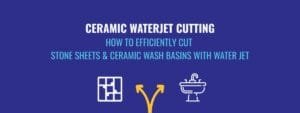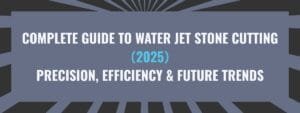When it comes to precision cutting in manufacturing, water jet cutting and laser cutting are two prominent techniques. Comparing them in terms of core technical parameters, water jet cutting uses high-pressure water streams, often with abrasives, and can handle thicker materials, while laser cutting relies on concentrated laser beams for faster cuts on thinner ones. In terms of characteristics, water jet cutting is a cold process, ideal for heat-sensitive materials, whereas laser cutting may cause heat-affected zones. Their application scenarios also differ, with water jet cutting used in aerospace and food industries, and laser cutting prevalent in electronics and jewelry. To make the right choice for your processing needs and maximize profits, contact APW WATER JET SALES.
watch water jet cutting videos / download catalogs / check technology data
(一) Comparison of Core Technical Parameters
| Comparison Item | Laser Cutting | Water jet Cutting |
| Cutting Principle | High-energy laser beam melting/vaporizing materials (laser ablation) | High-pressure water mixed with abrasives for impact cutting (abrasive Water jet) |
| Cutting Speed | 1,778 mm/min (70 inches/min) | 508 mm/min (20 inches/min) |
| Heat-Affected Zone (HAZ) | Present (potential for local hardening/deformation) | None (fully non-thermal, preserving original material properties) |
| Cutting Precision | 0.15 mm (suitable for precision processing) | 0.5 mm (meeting most industrial-grade precision requirements) |
| Maximum Processing Thickness | 30–40 mm (dependent on laser power) | 250–300 mm (significant advantage in thick material cutting) |
| Noise Level | 75 dB (low-noise operation) | 90 dB (higher noise from high-pressure water flow) |
| Material Compatibility | Metals, plastics, composites, glass | Metals, ceramics, glass (except tempered glass and diamonds) |
(二) Technical Characteristics and Application Scenarios
| Comparison Dimension | Laser Cutting | Water jet Cutting |
| Processing Advantages | – High efficiency for thin materials (<20 mm) – Suitable for complex surfaces and intricate structures | – Universal material compatibility (cuts both hard and soft materials) – No thermal deformation in thick materials – Environmentally friendly zero emissions |
| Typical Applications | – Electronic component cutting (e.g., circuit boards) – Laser welding of automotive body panels | – Aerospace titanium alloy components – Stone relief carving and glass deep processing – Precision machining of thick steel plates |
| Limitations | – Limited thick material capability (>40 mm efficiency drops sharply) – Heat-sensitive materials prone to damage | – Slower cutting speed for thin materials (lower efficiency than laser) – Higher initial equipment investment (\(60k–\)450k) |
| Environmental Features | – Generates minor smoke/dust (requires dust collection equipment) | – No harmful gas emissions- Recyclable abrasives and wastewater |
(三) Process Selection Recommendations
• Priority for Laser Cutting:
- Processing metal/plastic parts <20 mm thick requires extreme precision (e.g., 0.1 mm level).
- Cutting low-heat-sensitive materials (e.g., common steel, acrylic).
• Priority for Water jet Cutting:
- Machining thick hard materials >50 mm (e.g., stainless steel, granite).
- Processing heat-sensitive materials (e.g., aluminum alloys, circuit boards).
- Environments requiring zero emissions (e.g., medical-grade or food processing).
Conclusion
Laser cutting and water jet cutting offer distinct technical advantages:
- Laser cutting leads to thin material precision and efficiency.
- Water jet cutting excels in thick material processing, material versatility, and environmental friendliness.
When making a practical selection between waterjet cutting and laser cutting, several critical aspects must be thoroughly considered. First and foremost is the material type. Conductive materials like metals can generally be processed by both methods, but for heat-sensitive materials such as certain plastics, rubber, and electronic components, waterjet cutting is preferred as it is a cold-cutting process that prevents thermal damage. Processing thickness also plays a significant role; waterjet cutting excels at handling thicker materials, while laser cutting is more efficient for thinner ones. Precision requirements are another key factor, with laser cutting often offering higher accuracy for fine details. Additionally, environmental standards can not be overlooked, as laser cutting may produce fumes and waste, while waterjet cutting is relatively cleaner. For complex parts, combining the two technologies can leverage their respective strengths, resulting in optimal production efficiency.




